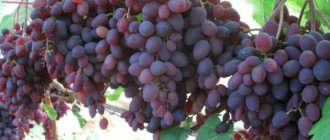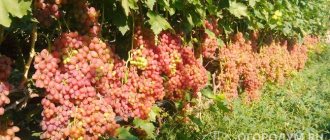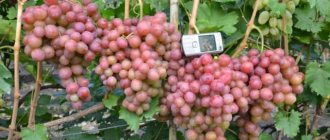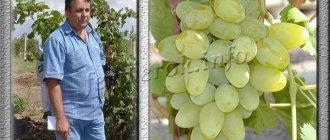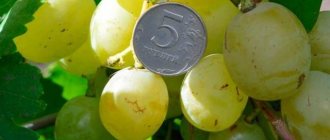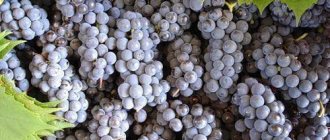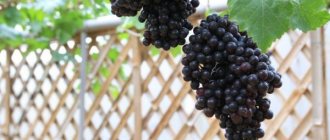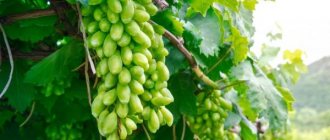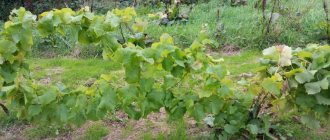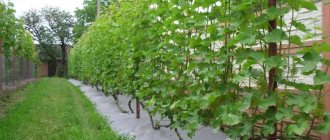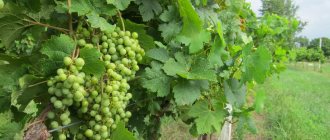Description and characteristics of the variety
The name Kishmish unites a large group of varieties that have several characteristics.
- The main distinguishing feature is the absence of seeds in the berry. In some hybrid varieties, seeds are still present, but they are so small and undeveloped that they are practically not felt.
- Kishmish clusters are dense or loose with small berries. Color depends on the variety. But, regardless of the variety, the berry has a dense structure and has excellent preservation.
- The pulp has a high sugar content - from 17 to 25%. This makes Kishmish an ideal berry for making raisins.
- Kishmish is a universal grape; it can be classified as a dessert and table variety at the same time. The berries can be eaten raw, dried, made into wine, or made into jam.
- All varieties are excellent pollinators.
- Kishmish is a very healthy food product. The vitamins and microelements it contains help to recover from a serious illness, support the heart muscle, and bring blood pressure back to normal.
This is probably where the general similarities end. Varieties have different ripening periods and frost resistance.
Popular varieties
Thanks to breeding work, heat-loving varieties of Kishmish can now be grown not only in central Russia, but also in colder regions. The most popular varieties differ not only in the color and size of the berries, but also in their set of characteristics.
- Kishmish Hungarian, or Kishmish 342, is a very popular variety. It is considered early, since it takes only 110–115 days to ripen. The plant is vigorous. The berries are medium-sized, light green. The mass of the brush is from 300 to 500 g. The pulp is tender, with a nutmeg flavor. Resistant to fungal diseases. Withstands frosts from 22 to -26°C. Used as a dessert variety, suitable for drying.
- Kishmish Aksai is an early ripening variety; the harvest can be harvested in late July - early August. Bushes of medium vigor. The bunch is large, conical in shape, with an average weight of 500 - 600 g. The berries are large, oval. The pulp has a pleasant harmonious taste with a light nutmeg aroma, and the sugar content is high. The berries are colored light pink, but become dark pink when fully ripe. Resistant to mildew, oidium, relatively resistant to gray rot. Presentation and transportability are good.
- Kishmish Century - a variety bred in 1966 in the USA, is famous throughout the world. The average ripening period is 120–125 days from the beginning of the growing season. The plant has a vigorous bush. The clusters are conical in shape, medium in density, very large - 700 - 1200 g. The berries are yellow-green, oval in shape, with a thin but durable skin. The pulp is homogeneous, slightly crispy, sweet. The taste is balanced, with a nutmeg aroma, sugar content 13%, acidity - 6 g/l. The variety has increased resistance to cracking, which ensures good presentation. But it doesn’t store very well—the berries quickly turn brown. Frost-resistant - can withstand down to -25°C.
- Kishmish Radiant is the only variety included in the State Register. Admission regions are Lower Volga and North Caucasus. Refers to varieties with an average ripening period of 125 – 130 days. A vigorous bush with medium-sized, five-lobed, strongly dissected leaves. The leaf blade is light green, with a shiny surface. The flower is bisexual. The brush is winged, loose, with an average weight of 413 g. According to some data, it can gain weight up to 1 kg. The berries have an elongated ovoid shape and are of medium size. The pink skin is dense, the flesh is pleasant to the taste, fleshy and juicy. The tasters' rating is very high - 9.1 points (on a 10-point scale). The average yield is 126 c/ha. It is affected by mildew by 4 points, gray mold by 3 points (the indicator is significantly lower than the standard), and by oidium by 1 point.
- Kishmish Moldavian is a medium-late variety; 155 days pass from bud break to the stage of technical ripeness. The bush is vigorous. The clusters are large, with an average weight of 600 g. The berries are round, sometimes oval, the skin is thin and durable, light purple with a slight waxy coating. The flesh is fleshy and crispy. The taste is harmonious and sweet. The variety is resistant to mildew and phylloxera. If leaf roller damage does not occur, the berries are resistant to gray rot. Withstands frosts down to -18°C. Shows excellent transportability and has a long shelf life.
The most popular varieties
You can choose a sultana variety based on various criteria - frost resistance, yield, bonyness, taste, color, ripening period, etc.
Thus, the above-mentioned groups of boneless sultanas include such varieties as sultanas Gold, Romulus, Korinka Russian, Perlette, Tairovsky pink.
You will find large and hard seeds in the grapes Kishmish Moldavsky, Zaporozhye, Radiant, Rusbol, hybrid form 311 and many others.
Please yourself and your family with such grape varieties as: “Gala”, “Anyuta”, “Anniversary of Novocherkassk”, “Talisman”, “Preobrazhenie”, “Veles”, “Lora”, “Timur”, “Arcadia”, “Kodryanka” ", "Libya", "Cardinal", "Rizamat", "Monarch", "Ruslan", "Original", "Sphinx", "Augustine", "Harold", "Valentina", "Lily of the Valley", "Helios", “Galahid”, “Victoria”, “Chameleon”, “Delight”, “Rochefort”, “Lancelot”, “Blagovest”, “Fun”, “Sofia”, “Lydia”, “In Memory of Negrul”, “Amursky”, “ Sensation”, “Ataman”, “Pretty Woman”, “Kesha”, “Moldova” and “Aleshenkin”.
On the other hand, the same Romulus, being an excellent raw material for preparing raisins, has
an unpleasant quality - its berries fall off very easily, leaving the winegrower without the desired harvest, while the mentioned Radiant sultanas stick perfectly to the bush.
Kishmish Zaporozhye is unpretentious, practically not afraid of wasps and has such a high yield that individual clusters must be removed in a timely manner to avoid overloading the vine.
High-yielding varieties also include Rusbol and Zosya, although the latter is characterized by low frost resistance, as well as general capriciousness and susceptibility to various diseases.
The most unpretentious varieties usually include isabella grape varieties, for example, Reliance Pink Sidlis or Einsens Sidlis, etc.
These raisins are well suited for beginners because, unlike higher-grade hybrids, they can forgive the owner for mistakes in care, pruning and other agricultural practices.
Kishmish grapes come in different colors - black, white, red.
Did you know? The largest amount of useful substances - vitamins and microelements - is contained in black grapes, and this rule applies not only to sultanas, but also to any other varieties of wine berries.
Useful information about the variety
Kishmish berries are tasty, healthy and versatile in use, but their use requires control. In order not to harm the body, take into account the specific properties of sultanas.
Nutritional and energy value
Kishmish is rich in vitamins and microelements:
- It contains a lot of B vitamins - they are the key to a strong nervous system. Eating these grapes helps cope with stress and depression.
- Nicotinic acid – normalizes metabolism.
- Ascorbic acid – strengthens the immune system.
- Potassium has a beneficial effect on the cardiovascular system.
- Boron – reduces the risk of osteoporosis.
- Oleanolic acid – reduces the rate of bacterial growth in the oral cavity.
Calorie content of Kishmish berries – 69 kcal per 100 g. Energy value:
- proteins – 0.72 g;
- fats – 0.16 g;
- carbohydrates – 17.2 g.
Glycemic index
Glycemic index (GI) is a parameter that determines the rate of breakdown of carbohydrates, which displays the magnitude of the change in blood glucose levels. Thus, the GI of sultanas is 56. Grapes are often used in diets, but they are contraindicated for diabetics, like any product whose GI is above 50.
What vitamins does it contain?
Kishmish is rich in vitamins; it is especially valued for its high content of vitamins A and C. But they are present only in ripe and well-dried berries.
100 g of raisins contains:
- Vitamin C – 6 mg;
- Vitamin A – 5 mcg;
- vitamin PP – 0.3 mg;
- vitamin B9 – 2 mcg;
- beta-carotene – 0.03 mg;
- vitamin H – 1.5 mcg;
- E-vitamin – 0.4 mg.
Application
Kishmish is used:
- As a useful, even medicinal product. Berries lift your spirits, relieve fatigue and have many other beneficial effects.
- In cooking. Used in baking, confectionery, and various dishes.
- For making homemade wine.
Harm from Kishmish
When consuming sultanas, you should take into account its high glycemic index, as well as the presence of organic acids. Kishmish is harmful for:
- obesity;
- diabetes mellitus;
- stomach ulcer;
- pancreatitis;
- cholecystitis.
The maximum dose of sultanas is 25 pieces per day. Exceeding the norm leads to flatulence, nausea and diarrhea - these symptoms can develop when overeating sultanas even in completely healthy people.
Marketability of berries
Kishmish does not always have a good presentation. A possible drawback of its bunches is insufficient density. It all depends on the size of the bunches and their appearance - these parameters depend on the Kishmish variety, its keeping quality and the ability of the bunches to maintain their presentation after the berries ripen.
The best varieties of sultanas
Finally, the dark days for raisins are over! The people ate their fill of beautiful sour wine in supermarkets (Turks, in pursuit of the third and fourth harvest of the year, harvest semi-green grapes - they have a marketable form, which means they will buy it - such Soviet logic) and began to pay attention to the not very flashy, but tasty sultanas. And, as a result, in the past season, the sultanas in the markets were sorted out at the moment
I don’t want to say that sultanas are better than table grapes with seeds (a matter of taste), but everyone who has grown a good seedless variety will never part with it. If not for sale, they will certainly keep a couple of bushes for themselves.
I know some amateur winegrowers who, having planted a sultana bush, fell in love with it so much that they did not want to switch to raisins and distributed the berries to friends or sold the surplus on the market.
But there is a smorgasbord of strife. By planting the first seedless variety you come across, you won’t achieve any special achievements. You should definitely consult with winegrowers and find out which variety in your area and on your soils is capable of producing the best harvest.
Rusbol
For example, the old seedless variety “Rusbol” seems to be quite good. It is relatively resistant to disease and tastes good, but it still has bones (albeit soft ones). You also have to be careful with the picking - when it gets overripe, it becomes cloyingly sweet and quickly becomes boring and the berries fall off a lot. All these shortcomings also apply to its American counterpart, Romulus.
Kishmish black
If you remember the old raisins, you cannot ignore “Kishmish Black”. Seedless, beautiful, tasty and productive. But very capricious. It is necessary to properly feed, normalize the load, and trim. In addition, it is susceptible to oidium and mildew. For beginners in viticulture, as well as lazy winegrowers like me, “Kishmish Zaporozhye” is more suitable. The new variety is cute, stable, tasty. But there are seeds.
Craftsmen recommend that in order to avoid such punctures, you need to load it harder - then the bones will become more edible. Fortunately, the variety is super-suicidal (it overloads itself shamelessly), so there are no problems with the load.
There are problems with a sense of proportion: if you underload, you’ll choke on the seeds; if you overload, you’ll be left without berries for a couple of years.
Kishmish 342
"Kishmish 342" is an excellent Hungarian variety. Exceptionally tasty, very stable sultana with small berries and large clusters. It's a covering variety, but that's not a problem - we have to cover almost all the grapes. The main thing is that it is suitable for growing even in the middle zone.
Relines pink seedlis
By the way, in the middle zone they are chasing “Realign Pink Seeds”. To the south they disdain it (they don’t like American varieties), but in vain. Everything about it is excellent. I don’t cover it, I spray it 1-2 times. I keep it as a good pollinator, and it is also very beautiful. Really reliable, very frost-resistant and resistant sultana. The berries are medium-sized, with an “isabelle” aroma, but without isabelle mucilage.
I don’t know how it will work on different soils, but I think it’s worth a try.
Einseth Seedlis
There are conflicting reviews about “Einset Seedlis” - a delicious small-berry raisin with the aroma of strawberries. Frost resistance and disease resistance are high - the gazebo variety. Reviews about it are contradictory; I myself cannot give it a “diagnosis” - the bush has not yet begun to bear fruit.
Glenora
Another American - "Glenora". Very stable, unpretentious, average winter hardiness. Taste with golden currant aroma, small berries. In rainy areas it has no value. It should be planted instead of "Isabella" and "Lydia". Also unpretentious and seedless!
Kishmish radiata
And be sure to plant at least one bush of “Kishmish radiata” - the most delicious and large-fruited seedless nutmeg. Considered a masterpiece among raisins. If you get the hang of it, it will outshine all other seedless varieties in beauty and taste. You just need to cover and spray it in full. But it's worth it!
grapes.hozvo.ru
The best sultana varieties and their characteristics
Despite the variety of raisin grape varieties, in each ripeness group there are several of the highest quality and most popular.
Early
Early ripening varieties give a good, abundant harvest even in the middle zone.
Kishmish 342, or Hungarian
The dessert variety is consumed fresh and is suitable for making wine and juices. The berries ripen at 110-115 days. The plant is tall, the clusters are large. The berries are light green with a golden sheen, tender, with a nutmeg flavor. The average fruit size is 16x18 mm.
Advantages include resistance to frost and fungal diseases. The fruits are also well digestible and ideal for drying. The main disadvantages are that the berries contain seeds; clusters picked at the wrong time quickly lose their presentation.
Aurora
Kishmish is consumed fresh and is also suitable for making wine. Aurora ripens in 110-120 days. It has conical, medium-sized clusters. The size of the berries is 15x15mm. The fruits are round, white-pink, juicy, sweet, with a strong skin.
Pros: high yield, frost resistance, good transportability. Disadvantages: instability to gray rot, attractive to birds.
Zaporozhye
It is considered a universal variety. Ripens at 110-120 days. The weight of the bunches reaches 1-2 kg. The berries are oval, small, purple in color. The pulp is juicy and sweet.
The main advantages are frost resistance (withstands temperatures down to -30°C) and high yield. Resistant to fungal diseases. Disadvantages of the variety: it is poorly stored, attracts insects, and is prone to overload with fruit if not properly cared for.
Mid-season
The varieties of this group are unpretentious in care.
Radiant
Table grape variety. Ripens in 125-135 days. The bushes are vigorous, the clusters are medium in weight from 500 g to 1 kg. The berries are cone-shaped, pink.
The main advantage is the sweet, juicy taste with notes of nutmeg. Another advantage of the variety is its resistance to many diseases, including gray rot. Tolerates transportation well. The disadvantage of this variety is its sensitivity to frost.
Moldavian
Delicious, juicy table raisins with a ripening period of 135-145 days. The plant is vigorous with large clusters weighing up to 600 g. The fruits are light purple, with a bloom, oval or round in shape. The weight of the berries is 4-6 g.
The main advantages are that they can be stored for up to 180 days, tolerate transportation well, and are resistant to frost. Disadvantages of the variety: it is often affected by gray mold and attracts pests (mainly leaf rollers).
Century
Widely used for making raisins. Ripens in 130-140 days. The clusters are heavy (up to 900 g), cone-shaped. The berries are oval, yellow-green, weighing up to 8 g, with thin skin. The berries are sweet, with a nutmeg flavor.
The advantages of the variety are high yield and versatility of use. The variety is also disease resistant. Disadvantages - does not tolerate transportation well and is not stored for long.
Late
Late-ripening varieties differ from others in their frost resistance.
Black finger
Refers to table varieties. Ripening period is 150-160 days. The clusters are cylindrical, large, weighing up to 2 kg. The berries are blue-black, oval, up to 3 cm long. The weight of one can reach 15 g. The berries are aromatic, with notes of nutmeg.
The main advantage is high productivity. The main disadvantage is sensitivity to disease.
White
Widely used in cooking and winemaking. The variety is suitable for growing in the middle zone and ripens in 170-180 days. The clusters are cylindrical in shape, their weight reaches 300 g. The berries are small, oval, yellow or light amber in color. The fruits are juicy with a sweet and sour taste.
The advantages include good frost resistance, and the disadvantages include low yield and poor transportability.
Red seedless grapes
Red sultana grapes are common due to their versatility. The varieties combine early-medium ripening and frost resistance (down to -29°C). Red sultanas belong to the table type. It is consumed fresh and juices are prepared.
Varieties of red seedless grapes:
- Red nutmeg. Ripens in 115 days and produces up to 5 kg of yield per bush. The average weight of the bunches is 750 g, the berries are 7 g. The fruits are oval and have a pronounced nutmeg taste.
- Kenadice. Ripening period – 120 days. The weight of the bunches is up to 500 g, the berries - up to 3 g. The fruits are round, juicy, sweet with the taste of Isabella.
- Kishmish Saturn. Ripens in 130 days. The clusters are conical, weighing up to 350 g. The berries are elongated, weighing 3-4 g. The pulp is sweet and juicy.
Kishmish Autumn Royal (Autumn Royal)
One of the largest-fruited seedless varieties. Kishmish was developed in the USA. Ripens late and is tested in the southern regions. The bushes are medium-sized. The clusters are large, weighing about 800 g. The berries are purple-black, weighing 6–8 g, thin-skinned. The taste is simple and harmonious. Resistant to frost down to -21°C, moderately resistant to diseases. The harvest is unstable. The quality of the berries depends on the load of the bush. Disadvantage - shedding of berries at the ripe stage. It is recommended to put covers on the bunches, which also protect the crop from wasps.
Classifications
All raisin varieties existing today are divided into several categories, taking into account seedlessness.
- Type 1 – there are no seeds or they are very small and cannot be felt during eating;
- 4 type has very large grains;
- 2 and 3 varieties are something between these two.
So if you buy a small juicy sultana and there are seeds in it, don’t be alarmed and don’t think that you were deceived - perhaps you just came across such a “seed” classification. Despite the low demand for sultanas with large seeds (grades 3 and 4), breeders are interested in these classes - they use them to breed new plant species. You can read more about the grape selection process here.
Kishmish 342: description of the variety
The berries of Hungarian grapes are medium-sized, weighing two to three grams. The peel is light in color, thin and delicate in taste. To prevent the berries from being damaged by wasps, mesh bags are placed on the bunch. There are no seeds in the berries, as well as rudiments.
The taste of the berries is sweet with nutmeg notes , the flesh is elastic, the sugar accumulation is about nineteen to twenty-one percent. The clusters are medium to large in size.
The variety accumulates wood, so brushes up to one kilogram are often found on adult bushes.
Hungarian sultanas ripen early; from the time of bud break to ripening, about one hundred ten to one hundred fifteen days pass. Grapes 342 can be eaten fresh and for drying raisins. Grapes keep well in the refrigerator for a long time.
Kishmish yields a high harvest ; from one bush you can get up to twenty-five kilograms. This variety bears fruit consistently. It is better not to overexpose ripe clusters on the branches, although some gardeners manage to keep them until the beginning of September. Hungarian grapes tolerate transportation well; this variety can even be used in baby food. Grapes 342 are frost-resistant, withstand temperature drops from twenty-two to twenty-six degrees.
Grape variety Kishmish: pros and cons
Kishmish is valued for such qualities as:
- the most important advantage is, of course, the absence of seeds, thanks to which it can be consumed both raw and dried.
- universal in use, used for making raisins, wine, juice.
- excellent taste, suitable for baby food.
- Most varieties are very frost-resistant, withstanding temperatures down to -25 degrees.
- Kishmish grapes are a good pollinator.
- supports the heart muscle, normalizes blood pressure.
- shows consistently high yields, 250 centners per hectare.
- cuttings take root well and take root, even in northern regions.
- early ripening.
- Most varieties tolerate transportation well, maintaining a decent presentation.
- Also, most varieties do not crack, but there are exceptions.
- They look nice and will decorate any area advantageously.
Minuses:
- Some varieties are prone to cracking and may fall out if left in bunches for too long. Therefore, you need to carefully monitor ripening, read the ripening dates of the variety in advance, and harvest on time.
- Average resistance to various pests, timely treatment is required.
Description of the best varieties with photos
Ripe bunch of Kishmish variety
The climate in our country is harsh. Previously, grapes were grown only in the south. Now, thanks to breeding work, varieties with early ripening fruits that are resistant to Russian frosts have been obtained. Gardeners in the Urals and Southern Siberia successfully breed them in their garden plots.
All new varieties are hybrids, there are many of them. You can always choose a variety of sultanas that overwinters well and ripens during the short summer. Consider the popular varieties of sultanas:
- Kishmish No. 342.
- Radiant raisins.
- Einset Seedless.
- Rusbol.
- Jupiter.
Kishmish No. 342
Bunch variety K. No. 342
Variety K. No. 342 can be grown in the middle zone, as it tolerates frosts down to -26°C. K. No. 342 has been very popular for many years. It is often called Hungarian sultana. Ripens early, within 110 days. K. No. 342 is a vigorous plant.
Large clusters weighing up to 500 g. Golden-green berries weighing about 3 g are medium in size. Rudiments (seeds) are absent. The pleasant, dessert taste of the pulp surprises with its sweetness and juiciness. The berries are grown for drying and table consumption.
Rusbol
Medium table Rusbol on a garden plot
Variety Rusbol table, early - sultana of Russian selection. The harvest is harvested in 105-115 days. The plant is tall. Clusters weighing from 600 g to 1.5 kg are formed on powerful vines. The density of the brushes is medium, the shape is conical.
The berries are oval in shape, white in color, weight from 2.5 g. The pulp of Rusbol is dense, with a harmonious combination of sweetness and sourness, juicy. Fruiting begins in the 2nd year. The variety responds well to fertilizing with potassium-phosphorus fertilizers. Grows best on vigorous rootstocks.
Kishmish Radiant
Bunch of the Radiant variety
Radiant is a raisin variety loved by winegrowers. It is considered the sweetest among seedless varieties. Kishmish Radiant consistently produces good yields. It belongs to the mid-early varieties (125 days), the harvest is harvested before September 1. The bushes are spreading, of medium height.
The berries are medium or large (2.5-4 g), collected in long 40 -45 cm conical clusters weighing from 600 g to 1 kg (1.5 kg). The pulp is crispy, dense, juicy, sweet and sour with the taste and aroma of nutmeg. The skin is pink.
Kishmish Radiant is not highly frost-resistant (-15°C), so even in the south it is recommended to cover it during the frost period. High yields are possible with good agricultural technology, which a competent winegrower can do.
Jupiter
Ripe variety Jupiter Sidliss
Kishmish Jupiter is an early variety (105-120 days), bred in North America. It is distinguished by high productivity. Medium-sized bushes begin to bear fruit 2-3 years after planting.
Clusters are formed weighing from 200 to 250 g. The shape of the brushes is cylindrical. The berries are oval, large (4-7 g), and may have rudiments. The skin is pink, sometimes red; in ripe berries it is dark blue, durable, and not susceptible to cracking.
The pulp has a nutmeg taste, juicy, dense, sweet. Kishmish Jupiter has good winter hardiness (-27°C) and resistance to fungal infections. The variety is valued for its high yield - 250 c/ha.
Einseth Seedlis
Einseth sidlis in the vineyard
Descendant of Isabella, the variety Einsett Seedlis, bred in the USA, is early in terms of ripening. It is distinguished by good frost resistance (down to -27°C). The bush is powerful and tall. The clusters are dense, conical, small in size, the average weight of the brush is about 250 g.
Small (2-3 g), pink or bright red oval-shaped berries are covered with a dense skin that is easily removed and does not crack. The juicy pulp is very aromatic and can be recognized by the characteristic strawberry smell of Isabella. The berries can be dried and consumed fresh. They are easy to transport. Stores well for 2-3 months.
Features of cultivation
The technology for planting this raisin grape variety, the description of which we reviewed in the article, involves planting cuttings no closer than 2.5 m to each other and maintaining a distance of about 3 m between rows. The pollinator is planted between varieties, with approximately the same flowering period.
Autumn planting lasts from October until frost. The principle of planting is the same as in spring, with the only difference being that the roots are carefully protected with soil, since they still need to overwinter. A plastic bottle with 3 holes made in it is placed on the seedling and filled with 3 buckets of water. Before frost, the plantings are insulated with sawdust or pine needles, after which the hole is filled up.
You can protect the seedling with soil by making a 30 cm high mound over it. When growing radiant sultanas, you need to constantly monitor the number of shoots and use supports to hold the weighty bunches.
Features of care
Its productivity depends on how competent care Kishmish receives.
Recent Entries
5 working ways to use tar in the garden 7 indoor plants that help you get married even in adulthood Indoor plants that can bloom in trouble
Watering and fertilizing
Kishmish loves watering. But too frequent and insufficient in volume will not bring benefits. In addition, the quality of the soil should be taken into account; for example, sandy soils require more moisture than chernozem.
Seedlings require special attention. They are watered every 4 days, especially if the weather is hot. 3-4 buckets of water should be poured under the young plant. To ensure that the moisture is absorbed evenly, divide this amount into 2 doses - morning and evening.
The most important watering periods for fruit-bearing grapes are:
- beginning of the growing season;
- a week before flowering begins;
- immediately after flowering;
- berry filling period.
2 weeks before harvest, watering is reduced by half.
There are many acceptable methods of watering for grapes, one of them is drip
Fertilizing should be done in moderation. For Kishmish, mixed feeding is considered favorable, alternating organic matter and complex fertilizers.
Fertilizer table
| Period | Fertilizer application rate |
| Early spring | To make the grapes grow faster, use a nitrogen-containing solution. To water one bush, dissolve in 10 liters of water:
Mineral fertilizer can be successfully replaced with organic fertilizer, for example, a manure solution. |
| A week before flowering | Prepare a solution of 65 g of nitrophoska and 5 g of boric acid (diluted in 10 liters of water). You can also use organic matter - 2 kg of manure per bucket of water. |
| Mid summer | The application of nitrogen is stopped so that the vines have time to ripen before the onset of cold weather. Therefore, before the grapes begin to ripen, superphosphate and potassium fertilizers are used - 20 g per 10 liters of water. |
| Mid autumn | A plant that has lost fruiting needs to regain its strength before the onset of winter. To do this, autumn feeding should consist of potassium and phosphorus, taken 25 g per bucket of water. |
Once every 3 years in the fall, you can add manure or compost for digging.
For Kishmish it is recommended to combine organic matter and mineral fertilizers
Foliar treatment to improve crop quality
During the flowering period of Kishmish grapes, the drug Gibberellin is used, which reduces the abscission of the ovary, as a result of which the yield increases. In addition, it increases the weight and sugar content of berries. For the same purpose, you can use the drug Ovary.
Trimming
Each grape seedling must be given shape in the first 3 to 4 years of development. Without this important technique, the plant will not be able to produce high-quality harvests and caring for it will be problematic.
Kishmish begins to be pruned in the spring, regardless of the planting date. As a rule, a cordon form is used with one, sometimes with two sleeves, which are most often directed in one direction.
According to this scheme, a single-arm cordon is formed
In order not to overload the bush, an average of 10 to 12 vines are allowed per 1 m of plant height. Since the variety is vigorous, long pruning is practiced for it - from 8 to 12 buds. Practice shows that in Asian varieties, to which Kishmish belongs, the first 4–5 buds are sterile, so it is advisable to use long pruning for them. After the shoots begin to grow, be sure to carry out normalization, removing barren buds and excess inflorescences, leaving 2 brushes on each shoot.
How many eyes to trim grapes - video
Preparing for winter
In the southern regions there is no need to cover grapes. But if you grow sunny berries in central Russia and further north, then this care method must be carried out.
- In the fall, weed the rows, since over the summer the soil there becomes compacted and the moisture reserves in it decrease. Loosened soil better captures and retains moisture.
- At the same time, destroy the weeds, as pests spend the winter in them.
- Fertilize with phosphorus-potassium fertilizers and pre-winter watering on time.
Young grape bushes are covered earlier than fruiting ones. The vines are untied, laid on the ground and pinned with iron or wooden staples. The top is covered with non-woven material and covered with earth. You can build boxes from plywood.
The vines removed from the support are pinned to the soil and then covered with non-woven material.
Features of reproduction
Kishmish reproduces in the usual way. Inside the berry, seed embryos are laid, called rudiments, which hatch under artificial conditions and go through several stages of growth and development before planting. The technology involves preserving the embryo.
The currant fruit sets without pollination, which implies a complete absence of seed material. Vegetative methods are used for propagation, including the use of layering and cuttings. Such propagation allows you to preserve all varietal properties. Seed propagation is necessary exclusively for the development of new grape varieties.
In recent years, it is seedless varieties and hybrids of grapes that are particularly popular among consumers and arouse keen interest not only among amateur gardeners, but also professional winegrowers, due to their high quality characteristics, sufficient stability and productivity. In addition, such varieties and hybrids are unpretentious in cultivation and require minimal, standard care.
How to care for a series of Kishmish grapes
To get a good harvest, you need to follow all the rules of care. In this case, loosening and weeding should be carried out every 2-3 weeks.
Watering and fertilizing
In June they are fed with organic fertilizers, in July with phosphorus-potassium fertilizers, and in early August with potassium fertilizers.
This unique grape needs regular watering, at least once a week. If there is a lack of water, the roots will actively grow deep into the ground, and the plant will wither and will not be able to provide any benefit.
Bush formation and pruning
For the first four years, pruning is done every year in early spring. At the same time, they try to leave 10-12 vines on each meter of height, and 10-12 eyes on each of them. Weak and diseased branches must be removed.
Shelter for the winter
They are fertilized with potassium-phosphorus fertilizers, untied from the support and placed on the ground. For the winter, cover with non-woven material and sprinkle with earth.
Growing this variety is possible not only in open ground, but also in a greenhouse
Characteristics
Kishmish 342 is a very productive and frost-resistant variety. In temperate climates, of course, it requires shelter for the winter, but it can easily withstand temperatures down to -26-27 C. With proper care, you can get up to 20-25 kg of berries from one bush.
It tolerates transportation well and can be stored for about 3-4 weeks. The only condition: harvest from the bush on time, because... it loses its taste and is severely damaged by wasps.
Such varieties as Nadezhda AZOS, Bazhena and Krasa Balki do not lose their qualities during transportation.
Landing place
Grapes are an exceptionally heat-loving plant, so the choice of location is especially important. If you cannot create the necessary conditions, it is better to abandon the idea of growing grapes. When choosing a place, you must remember that there should be no shade, only an open place, well heated.
If there is shadow at any time during the day, the fruits will not have time to ripen on time. Thus, places where there are houses and other structures in close proximity are not suitable. Also not suitable are places where there are large trees that form shade. The root system of trees will take vitamins and minerals from the soil. There should be no drafts or north winds.
That is, the ideal option is a southern or southwestern plot with a flat surface. It is necessary to check the depth of groundwater. Because Kishmish has a developed root system that goes deep. And if there is water nearby, the roots can fester and the plant die.
Kishmish grapes prefer loose and fertile soil that can pass oxygen and moisture to the roots. We choose loamy, light loamy, black soil or sandy soil. The latter is most suitable, but the water will drain quickly.
The sweetness of grapes directly depends on how much sunlight they receive. Considering that sultanas are vigorous in growth, we choose the most illuminated area. We begin to prepare the soil for planting in advance. If you are going to plant grapes in the spring, then, accordingly, we prepare the soil in the fall. It is necessary to carry out a number of procedures:
- It is necessary to level the surface of the soil, remove all excess, and remove weeds, stones, and debris.
- We dig the soil 65-70 cm deep. At the same time, add superphosphate (100 g per 1 sq. m) and humus (3 kg per 1 sq. m).
- Large lumps of earth do not need to be broken. Leave until spring - having accumulated moisture, they will break on their own.
- It is hardly possible to find ideally suitable, ready-made soil for planting grapes, unless this crop has already grown there. Therefore, it is recommended to prepare the ground yourself. If sandy soil predominates, then add peat and black soil. If there is clay in the soil, it is necessary to add more humus, black soil, sand and crushed stones. If it is acidic, then you need to add 1.5 kg of phosphate rock per 1 sq. cm of soil.
Rules for planting young seedlings
Kishmish grapes, depending on the variety, can be more or less capricious, but in general, planting and caring for any variety requires compliance with the same rules.
Optimal time
Vines, like trees, can be planted in spring or fall. Each method has its supporters.
Of course, autumn planting is good because a minimum amount of time passes between the time of digging up the seedling and the moment of planting, because it is unknown how the seedling will survive long-term storage during the winter; the risk of death here is quite high.
On the other hand, if the winter turns out to be too harsh, there is a high probability that the poorly strengthened and not fully rooted seedling may not withstand the frost and die.
Some winegrowers, having acquired a particularly rare variety of vine on occasion at a time when the ground has already begun to freeze, manage to plant grapes even in winter, choosing a particularly warm day with above-zero temperatures, so as not to expose the seedling to the risk of long-term storage and subsequent unpredictable planting results.
If you prefer spring planting, wait for stable warmth and the final disappearance of night frosts. The optimal time is from April 20 to May 20.
In autumn, planting is carried out in October or even later, but, of course, it is necessary to have time before frost. To prevent the seedling from freezing, you can cover it with a plastic bottle or dig it in with pine paws or peat.
Selecting a location
Wine berries love warmth and a lot of light, so if you don’t have such a place on your site, it’s better to choose another crop to grow. Also, you should not plant grapes in close proximity to a house or other buildings from the west or east, since during one or another part of the day in this case a shadow will fall on the vine and the berries will not ripen as expected.
Trees are bad neighbors for grapes : in addition to providing unnecessary shade, they interfere with the development of the root system of the vine, suppressing it with their roots.
Did you know? If you plant grapes on the south side of a permanent structure or wall, the vine will be protected from the north wind and, in addition, will receive additional heat from the heating surface.
The roots of grapes are located at great depths, therefore, when choosing a place for planting, you need to make sure that there is no high groundwater in this place or make layering, otherwise the roots will rot and the grapes may die.
You should not plant the vine near a cesspool or fire pit, as grapes love clean soil. Also, this plant does not tolerate dust well, so you should also try to protect the planting from the road.
The ideal place for wineberry bushes is a southern slope (the southwestern side of the hill is also suitable). The distance between seedlings should be at least two meters.
Step by step planting process
We dig holes 0.7 m deep, 0.4 m wide, 0.8 m long (the long part of the hole should be located from north to south).
At the bottom of each hole we place a layer of ash and superphosphate, then a drainage layer (fine gravel, crushed stone, expanded clay, etc.).
Next we place the soil mixture in the hole: sand, humus and fertile soil.
On the south side of the pit we install any pipe (for example, rubber) with a diameter of at least 5 cm and a length of about a meter (the end of the pipe should rise above ground level by at least 5-10 cm. We strengthen the pipe with gravel, sprinkle it with earth and tamp it down well.
To the north of the pipe, at the bottom of the hole, we pour a small mound of fertile soil, in the center of which we place a seedling, slightly tilting it away from the pipe to the south. We fill the hole.
Important! When planting a seedling, two buds should remain underground, the rest on top. The upper two eyes can be trimmed immediately after planting, this will speed up the growth of the bush.
We water the seedling. Watering the grapes with this technology will be carried out directly through the pipe, so the moisture will easily reach the roots of the vine.
Peculiarities
There are no seeds in sultana fruits due to the lack of independent development of this direction as a separate variety. That is why it is almost impossible to find white berries in nature - they arose as a result of mutation of the buds of other plants that contain seeds. Kishmish vines are tall and quickly gain strength and power (they are considered the most powerful among all varieties).
The leaves are rugged, smooth, their edges are curved upward. The vines ripen at an average pace, the maximum load is about 70 buds. It is recommended to prune by about 10 buds. Hermaphrodite flowers have 5 stamens of a length similar to the length of the pistil.
The grape bunches are medium in size, although there are also quite large varieties with several branches. The berries fit tightly to each other, the shape is cylindrical. The top of the sultana is divided in two. The fruits are small, elongated, the color depends on the variety (there are yellow, amber and even dark berries). The skin is almost transparent, tears easily, and is covered with a waxy coating. The taste is sweet, there is a slight sourness.
Kishmish grapes have a sweet taste with a slight sourness.
Characteristic
When planting a Kishmish bush on a site, it is necessary to take into account the fact that it grows profusely. Therefore, when planting, the plant is given a sufficient area for normal growth.
Due to their growth, bushes constantly create overload, so they need frequent rationing. Experienced gardeners recommend pruning at least 6-8 buds. Under these conditions the vines will ripen well and more than 85% of the vines can be expected to bear fruit. The optimal load per shoot can be considered 2-3 bunches.
In addition to being consumed raw, 342 is actively used for processing into raisins. If the bunch is twisted, the berries can turn into raisins right on the plant.
These grapes are great for making baby food.
Kishmish 342 boasts stable and rich yield. With good care, one plant can produce up to 25 kg of marketable berries.
After ripening, the Kishmish berry, if not picked, quite quickly loses its taste and external qualities. Therefore, a ripe bunch should be picked immediately and sent to the market or for storage.
Without covering, the vine can withstand temperatures down to -22 degrees Celsius. If you cover the 342nd, then you can save it even at -26 degrees below zero.
As mentioned above, grapes cannot boast of large clusters. On average, they rarely exceed the 500 gram mark. But, if you take good care of the plant and grow the fruit “for a record,” then you can quite get a 1000-1500 gram bunch.
The berries are small, about 5-6 grams. Covered with a thin, transparent shell that is not felt when consumed. The sugar content is at a fairly high level - about 20%. Because of this, grapes are often attacked by wasps. To protect it, special nets are used in which each bunch is placed.
Features of planting and growing grapes
An important condition for growing Kishmish is the presence of at least 120 warm days throughout the year. In a shorter period it will not have time to ripen.
Kishmish Nakhodka
Landing dates
In the southern regions they are planted in October or November. Within a month before the onset of frost, the grapes take root and begin to develop vigorously in early spring. In northern climates it is planted in early spring.
Site selection and soil preparation
It is necessary to choose an area well lit by the sun. There should be no bushes or trees nearby. Strong wind or drafts are not allowed. Most types of soil will do, but fertile, loose soil is most favorable.
Before planting, the area must be cleaned: remove weeds and dig up. In this case, it is recommended to add humus (3 kg per 1 m²), superphosphate (100 g per 1 m²).
How to choose the right seedling
It is recommended to choose seedlings 1-2 years old. You need to pay attention to ensure that they have a healthy root system. There should be no sagging or stains on the trunk
It is desirable to have several kidneys.
Planting process step by step
You need to do the following:
- Dig holes 80 cm deep and 80 cm in diameter.
- Drainage is placed at the bottom (broken brick will do).
- The dug up soil is mixed with fertilizer consisting of rotted manure (2 buckets), superphosphate (200 g), potassium salt (100 g).
- A support is installed in the hole.
- Spread the prepared mixture in a thin layer and pour water over it. Make a hole in which the seedling is placed.
After watering, the ground is covered with a layer of mulch.
Planting a seedling must occur according to a certain pattern
Disease Prevention
Since sultanas ripen early, mildew bypasses them. However, the grapes need to be treated with Bordeaux mixture in the spring. Do not allow dirt to get into the cut areas. Kishmish is often attacked by wasps; to get rid of them, you should spray with vinegar and fumigate with smoke. You can also use traps with sugar syrup and chlorophos. The last method is boric acid, which is poured onto the jam.
To get rid of spider mites, you need to use insecticides, preventing the mite from spreading to the upper parts of the bush. Before planting grapes, you need to check the soil for the presence of May beetle larvae. Insecticides are also used to control caterpillars.
When to plant Kishmish grapes
To plant one variety or another, you must first decide which one is suitable for your climate zone. As we can see, there are a lot of varieties. We hope our article will help you make the right choice.
Planting dates also depend on your weather. If you have a very cold winter, then you should not plant grapes in the fall; they will not survive the winter. In this case, we plant sultanas in the spring. It will have time to take root sufficiently over the summer.
The temperature in the soil should be approximately 10 degrees. Such soil is usually in April-early May. If it is lower, the roots may freeze without taking root.
In autumn we plant in the southern regions, with relatively warm winters. But there is a big risk here: the rooting period is short, not all seedlings will survive the winter. The optimal planting time is October, before frost. To prevent the grapes from freezing, you can make a shelter for them from a plastic bottle or sprinkle them with earth. It is customary to plant cuttings in the fall, and seedlings in the spring.
Landing on time
Kishmish can be planted in both spring and autumn
Kishmish can be planted in both spring and autumn. Autumn planting is more often used in the southern regions. Usually planted in early October, when there is no threat of frost. For the winter, the seedlings are well insulated: a mound of soil is poured, and the top is covered with film or other protective material. In the northern viticulture zone, autumn weather is unreliable, so it is better to plant grapes in the spring. Dates vary from late April to late May. Dormant seedlings are planted before buds open, when the soil warms up to 10–12°C. Green seedlings rooted in containers can be planted in June.
Diseases and pests
Only healthy grapes can bear fruit abundantly and show high quality fruit. Therefore, the prevention and protection of plants from diseases and pests must be approached responsibly.
- White rot. Initially, the ridge and stalk of the grapes are affected. Then the fungus spreads to individual berries, and then covers the entire bunch. The berries become lethargic, turn red and fall off. Diseased vines become covered with round spots, edged with a black rim. In the affected areas, the bark is soaked. In damp weather, you can see the spores of the pathogen - dirty white dots. They form on affected berries and areas of the vine. The problem most often appears after sunburn, hail, or mildew. The disease is treatable; measures to combat it include spraying with a 4% solution of Bordeaux mixture, 5% Captan solution or 1% TMTD suspension. Prevention:
- fulfillment of agricultural technology conditions;
- The pruning regime must be especially strictly observed so that the bushes are well ventilated and illuminated by the sun.
- Gray rot. The disease can appear on berries at the very beginning of their formation. But the most affected are grapes that have begun to ripen or have already begun to ripen. The berries become covered with brown spots, the skin cracks on them, and a gray fluffy coating appears - sporulation of the fungus. If the autumn is dry, then the fungus causes the berries to raisin, the so-called noble rot. Brushes affected by gray rot are not suitable for transportation and storage. Unfortunately, there is no effective treatment for the fungus. Therefore, all efforts should be directed towards preventive measures:
- timely breaking off and tying up shoots;
- thinning the leaf mass so that the berries have greater access to sunlight;
- At the first sign of damage, the entire crop should be immediately removed.
- Rubella. The disease primarily affects the leaves. At the end of April - beginning of May, light spots appear on them, which then spread between the veins. On varieties with light berries, they become brown with a narrow waxy-yellow border. On dark varieties, the color of the spots is bright burgundy with a yellow-green border. Affected leaves dry out and fall off prematurely. The consequence of rubella can be inhibition of the growth of shoots, inflorescences and ovaries. The taste of the grapes may not change for the better. If rubella appeared last season, then in the spring, as soon as the leaves begin to appear, spray 2–3 times with 1.5–2% Bordeaux mixture or 0.5% Zineb solution. The interval between procedures is 5 – 10 days. Further treatment is the same as against mildew - 1% solution of Bordeaux mixture. Timely fertilizing and proper soil care will help reduce the risk of disease.
- Leaf roller. The leaf roller caterpillar damages buds, ovaries and berries. One caterpillar can destroy up to 50 buds. If the berries are damaged, then harmful microorganisms develop on them, leading to rotting, first of individual fruits, and then of the entire cluster. For butterflies, baits are made in the form of containers hung among the bushes at a height of 70 cm from the soil surface. Wine dregs, diluted 1/3 with water, are poured into the trap. Treatment with Vofatox (2.5 - 3 g of the drug per 1 m²) or Methylethylthiophos (15 g per 10 l of water) is used against caterpillars. For the purpose of prevention, immediately after removing the winter shelter, you should peel off the old bark in which the pupae overwinter and burn it.
- Wasps. These insects, attracted by the sweet taste of the berries, spoil their skin, making the grapes unable to be stored. In addition, damaged berries undergo a rotting process, which extends to whole fruits. You can fight wasps in different ways. This includes the use of pesticides, special traps and poisoned baits, and the destruction of nests. But if you consider wasps to be beneficial insects, then measures to combat them may not be so radical. You can, for example, plant plants around the grape bushes whose smell is not to the taste of wasps - mint, lemon balm, basil. And in addition to this, put special protective bags made of tulle on the ripening bunches of grapes.
Grape care
Mulching grapes Kishmish 342
Taking care of your plant always pays off. A large, tasty harvest of high quality and a long shelf life is ensured if several procedures are performed on time.
- Watering is not necessary, but regular. It is important to ensure that the soil is not very dry, otherwise the bush may begin to hurt.
- The soil under the bush must be loose so that oxygen can penetrate the soil.
- Mulching won't hurt, but it's not necessary either. It is done so that the water evaporates less and in order to reduce the number of weeds under the bush.
- In early spring, you can add nitrogen to the soil. And after harvesting, it is worth adding phosphorus-potassium fertilizers to the soil. This will allow the plant to recover faster after fruiting.
- Since the bushes of this variety are prone to overgrowth, it is recommended to trim them regularly. Pruning is carried out 2 times a year. In the spring, to remove frozen vines and form a neat bush, and in the fall, to remove diseased, damaged vines, as well as some of the young, excess branches. Kishmish 342 is prone to growth, but does not like thickening, so pruning is mandatory for it.
- The main enemy of the Kishmish 342 grape is wasps. They love sweet berries very much, so protection is required from them. You can put the bunches in special bags or install repellers. For other insect pests, spraying with insecticides or preventive treatment with folk remedies (potassium permanganate, herbal infusion, ash) is required.
The largest raisins
The quality of seedless grape varieties - sultanas - is rarely assessed by the size of the berries or bunches. For sultanas, the class of seedlessness (that is, soft seeds or their complete absence) comes first, as well as taste, yield and disease resistance. And yet the soul wants something bigger.
Variety of the Ukrainian folk breeder Zagorulko - Veles
Popular sultanas
Take, for example, the now popular Kishmish No. 342. It is already larger than many - the berries weigh up to 3.5 g. That is, the size of the Early Russian, only without seeds and bunches of half a kilo. Considering that it has no rudiments at all, but has a high yield, this raisin is more than worthy.
Kishmish radiata is larger - berries up to 4 g and clusters up to 600 g. And the berry is not round and white like 342, but elongated and pink. In general, it is more marketable and more beautiful. But the bones, although soft, are there. And this variety is not indifferent to diseases, frost resistance is lower... Much more capricious. High maintenance requirements.
Even larger is the sultana variety of the Ukrainian folk breeder Zagorulko - Veles. At the winegrowers' conference, the variety won two medals at once. There is something to brag about: the berries are 4.5-5 g - this is almost the size of ordinary grapes. And the color is like Kishmish radiata, the shape of the berry is also a little similar. And the clusters are larger.
But most of all, everyone likes its taste - the berry is dense, crispy, nutmeg, and you can’t feel the skin when eating it. Seedless – class 3 (rudiments are almost not felt).
It's hard to beat this variety. Although information appears periodically about sultanas with berries in 10. But this, apparently, is either the success of the “chemists” or a banal deception. If you believe the breeders, it has still not been possible to achieve such a berry in sultana varieties.
Kishmish Black Azos
American Venus
However, there are other varieties. For example, frost-resistant and unpretentious Venus. Why is he so good? What I liked the most was the aroma. But there is a drawback - thick skin.
Venus is very frost-resistant. Resists frosts down to -270C. That is, it can be grown in the South without covering it in a gazebo instead of the boring Isabella. Moreover, the size of its berries is no less - the same 3 g.
It is resistant to diseases, but the clusters are small - 200 each. But seedless class 1.
Black EPA
Kishmish Black AZOS of medium ripening period is very interesting. The clusters are large, loose, 700 g each. The berries are even larger than those of Veles - 6 g, round, dark purple. The skin is dense. The pulp is fleshy, seedless.
The yield is decent - 7-8 kg per bush, which is almost a record for sultanas. Moreover, this variety is highly resistant to fungal diseases, pests, and frost. And the tasting score is high 8.2 points.
So there are also unpretentious large sultanas. There is something to replace the old arbor varieties.
Kishmish radiata: features, planting, care
Kishmish radiata grapes are a high quality variety without seeds. According to the ripening period, it belongs to early-medium. The bushes are strong and medium-sized. The leaves are formed on a long petiole and have a soft green color.
The fruits are golden-pink or pink-red, slightly elongated. The weight of each berry is from 2.5 to 4 g. The berries are collected in clusters, which sometimes grow up to 40 cm in length and weigh from 200-600 g, and with proper care - up to 1 kg. Shrubs form up to 70% of fruit-bearing shoots. Sugar content of berries is up to 21%.
The fruits are golden-pink or pink-red, slightly elongated. The weight of each berry is from 2.5 to 4 g. The berries are collected in clusters, which sometimes grow up to 40 cm in length and weigh from 200-600 g, and with proper care - up to 1 kg. Shrubs form up to 70% of fruit-bearing shoots. Sugar content of berries is up to 21%.
Benefit
Seedless grapes have a lot of beneficial properties that everyone should know about. Thus, the best varieties of this crop contribute to:
- removal of toxic substances;
- increasing the body's defenses;
- improving blood counts;
- relief of colds and viral infections;
- rejuvenation of the whole body.
If you are not in the mood, you are overcome by depression, every morning you wake up depressed and overwhelmed, try starting the day with a small bunch of grapes. Eat it slowly, without rushing, savoring each berry and enjoying the rich taste.
Isn’t it true that life is sparkling with bright colors again? If you have a rainy weekend ahead, devote it to preparing an unusual delicacy - grape jam or jam. Don't like jam? No problem! Make a large bowl of fruit salad with grapes, drizzle with lemon juice, sprinkle lightly with powdered sugar and eat the whole thing. Your mood will improve immediately, don’t even doubt it!
How to choose the right grape seedlings when purchasing
There are several universal rules for purchasing any plant material.
First , it is very advisable to buy goods in a trusted place: ideally, from a familiar farmer (who will also give you all the necessary recommendations and answer all your questions) or at least in a trusted store (preferably a specialized store, not a supermarket), or an Internet site.
Another good tip is to take a specialist with you who will make the choice for you and protect you from making the wrong purchase.
If you have to make a choice yourself, use the following tips:
- There is no need to buy seedlings with dried out roots (if your grandmother is standing on the road in the open sun and selling dug up vines, drive by with confidence , you are unlikely to be able to revive such grapes).
- If you are going to plant grapes in the fall, do not buy seedlings with leaves : when digging up a seedling, the leaves need to be cut off, otherwise the bush will quickly dry out and then may not take root.
- You need to purchase seedlings only in season : if in the entire bazaar you see only one seller who was the first to “grow” the goods for planting, think about what methods he used to make the vine look formed. In addition, storing a seedling for a long time before it is time to plant it in the ground is also a big risk that the grapes will not take root . Buy on time and plant immediately!
- Ask the seller to cut off the “head” of the seedling a few millimeters or carefully scrape off a small section of bark to make sure that the vine is alive (the seedling should have green and slightly moist flesh when cut). You also need to check the roots of the seedling by cutting off a small tip and carefully examining the cut - at a living root it is light and moist, similar to a potato cut in half, at a dead root it is dry and dark.
- Gently bend the vine : it will break when dry (a slight crack when bending is normal). Lightly press the eyes on the seedling with your finger - they should not break off.
- Check whether the seedling's graft has taken root: take it with one hand above the graft, with the other below, and gently twist it, as if you want to wring out laundry. The fusion must be absolute - no cracking , no gaps should appear at the grafting site.
- The scion should be about 0.5 cm thick and have at least five bright brown buds. Inspect the seedling thoroughly for the absence of any mechanical damage, traces of mold, stains and strange thickenings (both on the scion and on the rootstock).
- The grafting site, however, must be visible: if you do not see it yourself, do not take the seller’s word for it - they are offering you an ungrafted seedling. The thickness of the rootstock and scion should differ markedly; in addition, an ungrafted seedling usually has a more powerful root system than a grafted one.

